Refine search
No keyword found to refine search
keywords EN
Places
Names
5214 documents found
| 1 | 87 |
Documents per page :

Rally at the Embassy of the United States of America in Kyiv
Yevhen Vasyliev / Le Pictorium
LePictorium_0303726.jpg
On March 1, 2025, a rally in support of Ukraine and its people was held at the Embassy of the United States of America in Kyiv. The rally was organized by the American community.

Rally at the Embassy of the United States of America in Kyiv
Yevhen Vasyliev / Le Pictorium
LePictorium_0303727.jpg
On March 1, 2025, a rally in support of Ukraine and its people was held at the Embassy of the United States of America in Kyiv. The rally was organized by the American community.

Rally at the Embassy of the United States of America in Kyiv
Yevhen Vasyliev / Le Pictorium
LePictorium_0303728.jpg
On March 1, 2025, a rally in support of Ukraine and its people was held at the Embassy of the United States of America in Kyiv. The rally was organized by the American community.

Rally at the Embassy of the United States of America in Kyiv
Yevhen Vasyliev / Le Pictorium
LePictorium_0303729.jpg
On March 1, 2025, a rally in support of Ukraine and its people was held at the Embassy of the United States of America in Kyiv. The rally was organized by the American community.

Rally at the Embassy of the United States of America in Kyiv
Yevhen Vasyliev / Le Pictorium
LePictorium_0303730.jpg
On March 1, 2025, a rally in support of Ukraine and its people was held at the Embassy of the United States of America in Kyiv. The rally was organized by the American community.

Rally at the Embassy of the United States of America in Kyiv
Yevhen Vasyliev / Le Pictorium
LePictorium_0303731.jpg
On March 1, 2025, a rally in support of Ukraine and its people was held at the Embassy of the United States of America in Kyiv. The rally was organized by the American community.

Rally at the Embassy of the United States of America in Kyiv
Yevhen Vasyliev / Le Pictorium
LePictorium_0303732.jpg
On March 1, 2025, a rally in support of Ukraine and its people was held at the Embassy of the United States of America in Kyiv. The rally was organized by the American community.
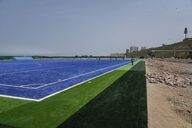
El Niño phenomenon on the north coast of Peru
Nicolas Réméné / Le Pictorium
LePictorium_0281286.jpg
Construction of the Alberto Junior Rodríguez Valdelomar sports ground in the San Miguel district of Lima, Peru, on 7 October 2018. Urban development work is trying to gain a little on the Peruvian capital's coastline. Lima, like many coastal towns and villages in the north has to deal regularly with the climatic hazards caused by the periodic alternation of the El Niño and La Niña phenomena. ---------------------------------------- The El Nino phenomenon on the north coast of Peru North of Lima in Peru, along almost 1300 km of coastline, many villages are periodically subjected to the climatic phenomena known as El Niño and La Niña. La Niña occurs more often, but is much less severe. As for El Niño, it recurs every 3 to 7 years. It is the result of disruptions to the oceanic and climatic system in the equatorial Pacific, particularly around the Peruvian and Ecuadorian coasts of South America. This phenomenon, which has a major influence on the world's climate, results in a surge of warm water in the Pacific Ocean and a rise in water levels that can lead to torrential rain, major flooding and landslides. These extreme weather events have had dramatic consequences for many of the villages along the coast. Many of these villages are fishing villages, where small-scale fishing is an essential part of the local economy, but El Niño has tended to warm surface waters, resulting in a reduction in plankton and therefore fish, turning the whole food chain upside down. In recent decades, the El Niño phenomenon has reappeared on several occasions, affecting ecosystems that are already particularly vulnerable to climate change, and causing a migratory flow of fish.
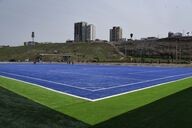
El Niño phenomenon on the north coast of Peru
Nicolas Réméné / Le Pictorium
LePictorium_0281287.jpg
Construction of the Alberto Junior Rodríguez Valdelomar sports ground in the San Miguel district of Lima, Peru, on 7 October 2018. Urban development work is trying to gain a little on the Peruvian capital's coastline. Lima, like many coastal towns and villages in the north has to deal regularly with the climatic hazards caused by the periodic alternation of the El Niño and La Niña phenomena. ---------------------------------------- The El Nino phenomenon on the north coast of Peru North of Lima in Peru, along almost 1300 km of coastline, many villages are periodically subjected to the climatic phenomena known as El Niño and La Niña. La Niña occurs more often, but is much less severe. As for El Niño, it recurs every 3 to 7 years. It is the result of disruptions to the oceanic and climatic system in the equatorial Pacific, particularly around the Peruvian and Ecuadorian coasts of South America. This phenomenon, which has a major influence on the world's climate, results in a surge of warm water in the Pacific Ocean and a rise in water levels that can lead to torrential rain, major flooding and landslides. These extreme weather events have had dramatic consequences for many of the villages along the coast. Many of these villages are fishing villages, where small-scale fishing is an essential part of the local economy, but El Niño has tended to warm surface waters, resulting in a reduction in plankton and therefore fish, turning the whole food chain upside down. In recent decades, the El Niño phenomenon has reappeared on several occasions, affecting ecosystems that are already particularly vulnerable to climate change, and causing a migratory flow of fish.
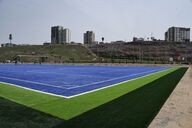
El Niño phenomenon on the north coast of Peru
Nicolas Réméné / Le Pictorium
LePictorium_0281288.jpg
Construction of the Alberto Junior Rodríguez Valdelomar sports ground in the San Miguel district of Lima, Peru, on 7 October 2018. Urban development work is trying to gain a little on the Peruvian capital's coastline. Lima, like many coastal towns and villages in the north has to deal regularly with the climatic hazards caused by the periodic alternation of the El Niño and La Niña phenomena. ---------------------------------------- The El Nino phenomenon on the north coast of Peru North of Lima in Peru, along almost 1300 km of coastline, many villages are periodically subjected to the climatic phenomena known as El Niño and La Niña. La Niña occurs more often, but is much less severe. As for El Niño, it recurs every 3 to 7 years. It is the result of disruptions to the oceanic and climatic system in the equatorial Pacific, particularly around the Peruvian and Ecuadorian coasts of South America. This phenomenon, which has a major influence on the world's climate, results in a surge of warm water in the Pacific Ocean and a rise in water levels that can lead to torrential rain, major flooding and landslides. These extreme weather events have had dramatic consequences for many of the villages along the coast. Many of these villages are fishing villages, where small-scale fishing is an essential part of the local economy, but El Niño has tended to warm surface waters, resulting in a reduction in plankton and therefore fish, turning the whole food chain upside down. In recent decades, the El Niño phenomenon has reappeared on several occasions, affecting ecosystems that are already particularly vulnerable to climate change, and causing a migratory flow of fish.
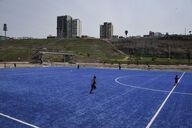
El Niño phenomenon on the north coast of Peru
Nicolas Réméné / Le Pictorium
LePictorium_0281289.jpg
Construction of the Alberto Junior Rodríguez Valdelomar sports ground in the San Miguel district of Lima, Peru, on 7 October 2018. Urban development work is trying to gain a little on the Peruvian capital's coastline. Lima, like many coastal towns and villages in the north has to deal regularly with the climatic hazards caused by the periodic alternation of the El Niño and La Niña phenomena. ---------------------------------------- The El Nino phenomenon on the north coast of Peru North of Lima in Peru, along almost 1300 km of coastline, many villages are periodically subjected to the climatic phenomena known as El Niño and La Niña. La Niña occurs more often, but is much less severe. As for El Niño, it recurs every 3 to 7 years. It is the result of disruptions to the oceanic and climatic system in the equatorial Pacific, particularly around the Peruvian and Ecuadorian coasts of South America. This phenomenon, which has a major influence on the world's climate, results in a surge of warm water in the Pacific Ocean and a rise in water levels that can lead to torrential rain, major flooding and landslides. These extreme weather events have had dramatic consequences for many of the villages along the coast. Many of these villages are fishing villages, where small-scale fishing is an essential part of the local economy, but El Niño has tended to warm surface waters, resulting in a reduction in plankton and therefore fish, turning the whole food chain upside down. In recent decades, the El Niño phenomenon has reappeared on several occasions, affecting ecosystems that are already particularly vulnerable to climate change, and causing a migratory flow of fish.
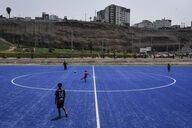
El Niño phenomenon on the north coast of Peru
Nicolas Réméné / Le Pictorium
LePictorium_0281290.jpg
Construction of the Alberto Junior Rodríguez Valdelomar sports ground in the San Miguel district of Lima, Peru, on 7 October 2018. Urban development work is trying to gain a little on the Peruvian capital's coastline. Lima, like many coastal towns and villages in the north has to deal regularly with the climatic hazards caused by the periodic alternation of the El Niño and La Niña phenomena. ---------------------------------------- The El Nino phenomenon on the north coast of Peru North of Lima in Peru, along almost 1300 km of coastline, many villages are periodically subjected to the climatic phenomena known as El Niño and La Niña. La Niña occurs more often, but is much less severe. As for El Niño, it recurs every 3 to 7 years. It is the result of disruptions to the oceanic and climatic system in the equatorial Pacific, particularly around the Peruvian and Ecuadorian coasts of South America. This phenomenon, which has a major influence on the world's climate, results in a surge of warm water in the Pacific Ocean and a rise in water levels that can lead to torrential rain, major flooding and landslides. These extreme weather events have had dramatic consequences for many of the villages along the coast. Many of these villages are fishing villages, where small-scale fishing is an essential part of the local economy, but El Niño has tended to warm surface waters, resulting in a reduction in plankton and therefore fish, turning the whole food chain upside down. In recent decades, the El Niño phenomenon has reappeared on several occasions, affecting ecosystems that are already particularly vulnerable to climate change, and causing a migratory flow of fish.
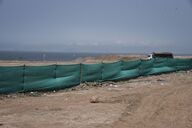
El Niño phenomenon on the north coast of Peru
Nicolas Réméné / Le Pictorium
LePictorium_0281291.jpg
Construction of the Alberto Junior Rodríguez Valdelomar sports ground in the San Miguel district of Lima, Peru, on 7 October 2018. Urban development work is trying to gain a little on the Peruvian capital's coastline. Lima, like many coastal towns and villages in the north has to deal regularly with the climatic hazards caused by the periodic alternation of the El Niño and La Niña phenomena. ---------------------------------------- The El Nino phenomenon on the north coast of Peru North of Lima in Peru, along almost 1300 km of coastline, many villages are periodically subjected to the climatic phenomena known as El Niño and La Niña. La Niña occurs more often, but is much less severe. As for El Niño, it recurs every 3 to 7 years. It is the result of disruptions to the oceanic and climatic system in the equatorial Pacific, particularly around the Peruvian and Ecuadorian coasts of South America. This phenomenon, which has a major influence on the world's climate, results in a surge of warm water in the Pacific Ocean and a rise in water levels that can lead to torrential rain, major flooding and landslides. These extreme weather events have had dramatic consequences for many of the villages along the coast. Many of these villages are fishing villages, where small-scale fishing is an essential part of the local economy, but El Niño has tended to warm surface waters, resulting in a reduction in plankton and therefore fish, turning the whole food chain upside down. In recent decades, the El Niño phenomenon has reappeared on several occasions, affecting ecosystems that are already particularly vulnerable to climate change, and causing a migratory flow of fish.

El Niño phenomenon on the north coast of Peru
Nicolas Réméné / Le Pictorium
LePictorium_0281292.jpg
Construction of the Alberto Junior Rodríguez Valdelomar sports ground in the San Miguel district of Lima, Peru, on 7 October 2018. Urban development work is trying to gain a little on the Peruvian capital's coastline. Lima, like many coastal towns and villages in the north has to deal regularly with the climatic hazards caused by the periodic alternation of the El Niño and La Niña phenomena. ---------------------------------------- The El Nino phenomenon on the north coast of Peru North of Lima in Peru, along almost 1300 km of coastline, many villages are periodically subjected to the climatic phenomena known as El Niño and La Niña. La Niña occurs more often, but is much less severe. As for El Niño, it recurs every 3 to 7 years. It is the result of disruptions to the oceanic and climatic system in the equatorial Pacific, particularly around the Peruvian and Ecuadorian coasts of South America. This phenomenon, which has a major influence on the world's climate, results in a surge of warm water in the Pacific Ocean and a rise in water levels that can lead to torrential rain, major flooding and landslides. These extreme weather events have had dramatic consequences for many of the villages along the coast. Many of these villages are fishing villages, where small-scale fishing is an essential part of the local economy, but El Niño has tended to warm surface waters, resulting in a reduction in plankton and therefore fish, turning the whole food chain upside down. In recent decades, the El Niño phenomenon has reappeared on several occasions, affecting ecosystems that are already particularly vulnerable to climate change, and causing a migratory flow of fish.
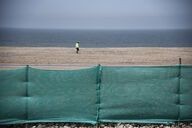
El Niño phenomenon on the north coast of Peru
Nicolas Réméné / Le Pictorium
LePictorium_0281293.jpg
Construction of the Alberto Junior Rodríguez Valdelomar sports ground in the San Miguel district of Lima, Peru, on 7 October 2018. Urban development work is trying to gain a little on the Peruvian capital's coastline. Lima, like many coastal towns and villages in the north has to deal regularly with the climatic hazards caused by the periodic alternation of the El Niño and La Niña phenomena. ---------------------------------------- The El Nino phenomenon on the north coast of Peru North of Lima in Peru, along almost 1300 km of coastline, many villages are periodically subjected to the climatic phenomena known as El Niño and La Niña. La Niña occurs more often, but is much less severe. As for El Niño, it recurs every 3 to 7 years. It is the result of disruptions to the oceanic and climatic system in the equatorial Pacific, particularly around the Peruvian and Ecuadorian coasts of South America. This phenomenon, which has a major influence on the world's climate, results in a surge of warm water in the Pacific Ocean and a rise in water levels that can lead to torrential rain, major flooding and landslides. These extreme weather events have had dramatic consequences for many of the villages along the coast. Many of these villages are fishing villages, where small-scale fishing is an essential part of the local economy, but El Niño has tended to warm surface waters, resulting in a reduction in plankton and therefore fish, turning the whole food chain upside down. In recent decades, the El Niño phenomenon has reappeared on several occasions, affecting ecosystems that are already particularly vulnerable to climate change, and causing a migratory flow of fish.
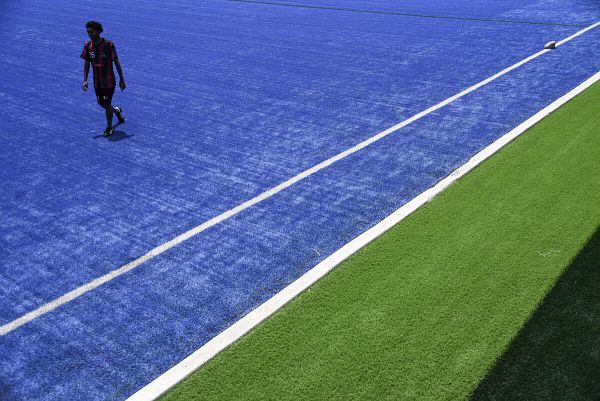
El Niño phenomenon on the north coast of Peru
Nicolas Réméné / Le Pictorium
LePictorium_0281294.jpg
Construction of the Alberto Junior Rodríguez Valdelomar sports ground in the San Miguel district of Lima, Peru, on 7 October 2018. Urban development work is trying to gain a little on the Peruvian capital's coastline. Lima, like many coastal towns and villages in the north has to deal regularly with the climatic hazards caused by the periodic alternation of the El Niño and La Niña phenomena. ---------------------------------------- The El Nino phenomenon on the north coast of Peru North of Lima in Peru, along almost 1300 km of coastline, many villages are periodically subjected to the climatic phenomena known as El Niño and La Niña. La Niña occurs more often, but is much less severe. As for El Niño, it recurs every 3 to 7 years. It is the result of disruptions to the oceanic and climatic system in the equatorial Pacific, particularly around the Peruvian and Ecuadorian coasts of South America. This phenomenon, which has a major influence on the world's climate, results in a surge of warm water in the Pacific Ocean and a rise in water levels that can lead to torrential rain, major flooding and landslides. These extreme weather events have had dramatic consequences for many of the villages along the coast. Many of these villages are fishing villages, where small-scale fishing is an essential part of the local economy, but El Niño has tended to warm surface waters, resulting in a reduction in plankton and therefore fish, turning the whole food chain upside down. In recent decades, the El Niño phenomenon has reappeared on several occasions, affecting ecosystems that are already particularly vulnerable to climate change, and causing a migratory flow of fish.

El Niño phenomenon on the north coast of Peru
Nicolas Réméné / Le Pictorium
LePictorium_0281295.jpg
Construction of the Alberto Junior Rodríguez Valdelomar sports ground in the San Miguel district of Lima, Peru, on 7 October 2018. Urban development work is trying to gain a little on the Peruvian capital's coastline. Lima, like many coastal towns and villages in the north has to deal regularly with the climatic hazards caused by the periodic alternation of the El Niño and La Niña phenomena. ---------------------------------------- The El Nino phenomenon on the north coast of Peru North of Lima in Peru, along almost 1300 km of coastline, many villages are periodically subjected to the climatic phenomena known as El Niño and La Niña. La Niña occurs more often, but is much less severe. As for El Niño, it recurs every 3 to 7 years. It is the result of disruptions to the oceanic and climatic system in the equatorial Pacific, particularly around the Peruvian and Ecuadorian coasts of South America. This phenomenon, which has a major influence on the world's climate, results in a surge of warm water in the Pacific Ocean and a rise in water levels that can lead to torrential rain, major flooding and landslides. These extreme weather events have had dramatic consequences for many of the villages along the coast. Many of these villages are fishing villages, where small-scale fishing is an essential part of the local economy, but El Niño has tended to warm surface waters, resulting in a reduction in plankton and therefore fish, turning the whole food chain upside down. In recent decades, the El Niño phenomenon has reappeared on several occasions, affecting ecosystems that are already particularly vulnerable to climate change, and causing a migratory flow of fish.

El Niño phenomenon on the north coast of Peru
Nicolas Réméné / Le Pictorium
LePictorium_0281296.jpg
Construction of the Alberto Junior Rodríguez Valdelomar sports ground in the San Miguel district of Lima, Peru, on 7 October 2018. Urban development work is trying to gain a little on the Peruvian capital's coastline. Lima, like many coastal towns and villages in the north has to deal regularly with the climatic hazards caused by the periodic alternation of the El Niño and La Niña phenomena. ---------------------------------------- The El Nino phenomenon on the north coast of Peru North of Lima in Peru, along almost 1300 km of coastline, many villages are periodically subjected to the climatic phenomena known as El Niño and La Niña. La Niña occurs more often, but is much less severe. As for El Niño, it recurs every 3 to 7 years. It is the result of disruptions to the oceanic and climatic system in the equatorial Pacific, particularly around the Peruvian and Ecuadorian coasts of South America. This phenomenon, which has a major influence on the world's climate, results in a surge of warm water in the Pacific Ocean and a rise in water levels that can lead to torrential rain, major flooding and landslides. These extreme weather events have had dramatic consequences for many of the villages along the coast. Many of these villages are fishing villages, where small-scale fishing is an essential part of the local economy, but El Niño has tended to warm surface waters, resulting in a reduction in plankton and therefore fish, turning the whole food chain upside down. In recent decades, the El Niño phenomenon has reappeared on several occasions, affecting ecosystems that are already particularly vulnerable to climate change, and causing a migratory flow of fish.

El Niño phenomenon on the north coast of Peru
Nicolas Réméné / Le Pictorium
LePictorium_0281297.jpg
Construction of the Alberto Junior Rodríguez Valdelomar sports ground in the San Miguel district of Lima, Peru, on 7 October 2018. Urban development work is trying to gain a little on the Peruvian capital's coastline. Lima, like many coastal towns and villages in the north has to deal regularly with the climatic hazards caused by the periodic alternation of the El Niño and La Niña phenomena. ---------------------------------------- The El Nino phenomenon on the north coast of Peru North of Lima in Peru, along almost 1300 km of coastline, many villages are periodically subjected to the climatic phenomena known as El Niño and La Niña. La Niña occurs more often, but is much less severe. As for El Niño, it recurs every 3 to 7 years. It is the result of disruptions to the oceanic and climatic system in the equatorial Pacific, particularly around the Peruvian and Ecuadorian coasts of South America. This phenomenon, which has a major influence on the world's climate, results in a surge of warm water in the Pacific Ocean and a rise in water levels that can lead to torrential rain, major flooding and landslides. These extreme weather events have had dramatic consequences for many of the villages along the coast. Many of these villages are fishing villages, where small-scale fishing is an essential part of the local economy, but El Niño has tended to warm surface waters, resulting in a reduction in plankton and therefore fish, turning the whole food chain upside down. In recent decades, the El Niño phenomenon has reappeared on several occasions, affecting ecosystems that are already particularly vulnerable to climate change, and causing a migratory flow of fish.
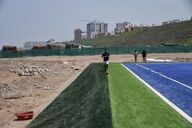
El Niño phenomenon on the north coast of Peru
Nicolas Réméné / Le Pictorium
LePictorium_0281298.jpg
Construction of the Alberto Junior Rodríguez Valdelomar sports ground in the San Miguel district of Lima, Peru, on 7 October 2018. Urban development work is trying to gain a little on the Peruvian capital's coastline. Lima, like many coastal towns and villages in the north has to deal regularly with the climatic hazards caused by the periodic alternation of the El Niño and La Niña phenomena. ---------------------------------------- The El Nino phenomenon on the north coast of Peru North of Lima in Peru, along almost 1300 km of coastline, many villages are periodically subjected to the climatic phenomena known as El Niño and La Niña. La Niña occurs more often, but is much less severe. As for El Niño, it recurs every 3 to 7 years. It is the result of disruptions to the oceanic and climatic system in the equatorial Pacific, particularly around the Peruvian and Ecuadorian coasts of South America. This phenomenon, which has a major influence on the world's climate, results in a surge of warm water in the Pacific Ocean and a rise in water levels that can lead to torrential rain, major flooding and landslides. These extreme weather events have had dramatic consequences for many of the villages along the coast. Many of these villages are fishing villages, where small-scale fishing is an essential part of the local economy, but El Niño has tended to warm surface waters, resulting in a reduction in plankton and therefore fish, turning the whole food chain upside down. In recent decades, the El Niño phenomenon has reappeared on several occasions, affecting ecosystems that are already particularly vulnerable to climate change, and causing a migratory flow of fish.
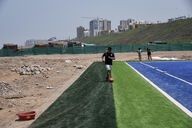
El Niño phenomenon on the north coast of Peru
Nicolas Réméné / Le Pictorium
LePictorium_0281299.jpg
Construction of the Alberto Junior Rodríguez Valdelomar sports ground in the San Miguel district of Lima, Peru, on 7 October 2018. Urban development work is trying to gain a little on the Peruvian capital's coastline. Lima, like many coastal towns and villages in the north has to deal regularly with the climatic hazards caused by the periodic alternation of the El Niño and La Niña phenomena. ---------------------------------------- The El Nino phenomenon on the north coast of Peru North of Lima in Peru, along almost 1300 km of coastline, many villages are periodically subjected to the climatic phenomena known as El Niño and La Niña. La Niña occurs more often, but is much less severe. As for El Niño, it recurs every 3 to 7 years. It is the result of disruptions to the oceanic and climatic system in the equatorial Pacific, particularly around the Peruvian and Ecuadorian coasts of South America. This phenomenon, which has a major influence on the world's climate, results in a surge of warm water in the Pacific Ocean and a rise in water levels that can lead to torrential rain, major flooding and landslides. These extreme weather events have had dramatic consequences for many of the villages along the coast. Many of these villages are fishing villages, where small-scale fishing is an essential part of the local economy, but El Niño has tended to warm surface waters, resulting in a reduction in plankton and therefore fish, turning the whole food chain upside down. In recent decades, the El Niño phenomenon has reappeared on several occasions, affecting ecosystems that are already particularly vulnerable to climate change, and causing a migratory flow of fish.
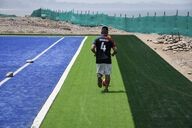
El Niño phenomenon on the north coast of Peru
Nicolas Réméné / Le Pictorium
LePictorium_0281300.jpg
Construction of the Alberto Junior Rodríguez Valdelomar sports ground in the San Miguel district of Lima, Peru, on 7 October 2018. Urban development work is trying to gain a little on the Peruvian capital's coastline. Lima, like many coastal towns and villages in the north has to deal regularly with the climatic hazards caused by the periodic alternation of the El Niño and La Niña phenomena. ---------------------------------------- The El Nino phenomenon on the north coast of Peru North of Lima in Peru, along almost 1300 km of coastline, many villages are periodically subjected to the climatic phenomena known as El Niño and La Niña. La Niña occurs more often, but is much less severe. As for El Niño, it recurs every 3 to 7 years. It is the result of disruptions to the oceanic and climatic system in the equatorial Pacific, particularly around the Peruvian and Ecuadorian coasts of South America. This phenomenon, which has a major influence on the world's climate, results in a surge of warm water in the Pacific Ocean and a rise in water levels that can lead to torrential rain, major flooding and landslides. These extreme weather events have had dramatic consequences for many of the villages along the coast. Many of these villages are fishing villages, where small-scale fishing is an essential part of the local economy, but El Niño has tended to warm surface waters, resulting in a reduction in plankton and therefore fish, turning the whole food chain upside down. In recent decades, the El Niño phenomenon has reappeared on several occasions, affecting ecosystems that are already particularly vulnerable to climate change, and causing a migratory flow of fish.
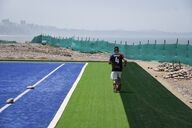
El Niño phenomenon on the north coast of Peru
Nicolas Réméné / Le Pictorium
LePictorium_0281301.jpg
Construction of the Alberto Junior Rodríguez Valdelomar sports ground in the San Miguel district of Lima, Peru, on 7 October 2018. Urban development work is trying to gain a little on the Peruvian capital's coastline. Lima, like many coastal towns and villages in the north has to deal regularly with the climatic hazards caused by the periodic alternation of the El Niño and La Niña phenomena. ---------------------------------------- The El Nino phenomenon on the north coast of Peru North of Lima in Peru, along almost 1300 km of coastline, many villages are periodically subjected to the climatic phenomena known as El Niño and La Niña. La Niña occurs more often, but is much less severe. As for El Niño, it recurs every 3 to 7 years. It is the result of disruptions to the oceanic and climatic system in the equatorial Pacific, particularly around the Peruvian and Ecuadorian coasts of South America. This phenomenon, which has a major influence on the world's climate, results in a surge of warm water in the Pacific Ocean and a rise in water levels that can lead to torrential rain, major flooding and landslides. These extreme weather events have had dramatic consequences for many of the villages along the coast. Many of these villages are fishing villages, where small-scale fishing is an essential part of the local economy, but El Niño has tended to warm surface waters, resulting in a reduction in plankton and therefore fish, turning the whole food chain upside down. In recent decades, the El Niño phenomenon has reappeared on several occasions, affecting ecosystems that are already particularly vulnerable to climate change, and causing a migratory flow of fish.

El Niño phenomenon on the north coast of Peru
Nicolas Réméné / Le Pictorium
LePictorium_0281302.jpg
Construction of the Alberto Junior Rodríguez Valdelomar sports ground in the San Miguel district of Lima, Peru, on 7 October 2018. Urban development work is trying to gain a little on the Peruvian capital's coastline. Lima, like many coastal towns and villages in the north has to deal regularly with the climatic hazards caused by the periodic alternation of the El Niño and La Niña phenomena. ---------------------------------------- The El Nino phenomenon on the north coast of Peru North of Lima in Peru, along almost 1300 km of coastline, many villages are periodically subjected to the climatic phenomena known as El Niño and La Niña. La Niña occurs more often, but is much less severe. As for El Niño, it recurs every 3 to 7 years. It is the result of disruptions to the oceanic and climatic system in the equatorial Pacific, particularly around the Peruvian and Ecuadorian coasts of South America. This phenomenon, which has a major influence on the world's climate, results in a surge of warm water in the Pacific Ocean and a rise in water levels that can lead to torrential rain, major flooding and landslides. These extreme weather events have had dramatic consequences for many of the villages along the coast. Many of these villages are fishing villages, where small-scale fishing is an essential part of the local economy, but El Niño has tended to warm surface waters, resulting in a reduction in plankton and therefore fish, turning the whole food chain upside down. In recent decades, the El Niño phenomenon has reappeared on several occasions, affecting ecosystems that are already particularly vulnerable to climate change, and causing a migratory flow of fish.

El Niño phenomenon on the north coast of Peru
Nicolas Réméné / Le Pictorium
LePictorium_0281303.jpg
Construction of the Alberto Junior Rodríguez Valdelomar sports ground in the San Miguel district of Lima, Peru, on 7 October 2018. Urban development work is trying to gain a little on the Peruvian capital's coastline. Lima, like many coastal towns and villages in the north has to deal regularly with the climatic hazards caused by the periodic alternation of the El Niño and La Niña phenomena. ---------------------------------------- The El Nino phenomenon on the north coast of Peru North of Lima in Peru, along almost 1300 km of coastline, many villages are periodically subjected to the climatic phenomena known as El Niño and La Niña. La Niña occurs more often, but is much less severe. As for El Niño, it recurs every 3 to 7 years. It is the result of disruptions to the oceanic and climatic system in the equatorial Pacific, particularly around the Peruvian and Ecuadorian coasts of South America. This phenomenon, which has a major influence on the world's climate, results in a surge of warm water in the Pacific Ocean and a rise in water levels that can lead to torrential rain, major flooding and landslides. These extreme weather events have had dramatic consequences for many of the villages along the coast. Many of these villages are fishing villages, where small-scale fishing is an essential part of the local economy, but El Niño has tended to warm surface waters, resulting in a reduction in plankton and therefore fish, turning the whole food chain upside down. In recent decades, the El Niño phenomenon has reappeared on several occasions, affecting ecosystems that are already particularly vulnerable to climate change, and causing a migratory flow of fish.
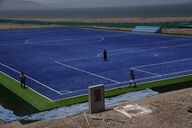
El Niño phenomenon on the north coast of Peru
Nicolas Réméné / Le Pictorium
LePictorium_0281304.jpg
Construction of the Alberto Junior Rodríguez Valdelomar sports ground in the San Miguel district of Lima, Peru, on 7 October 2018. Urban development work is trying to gain a little on the Peruvian capital's coastline. Lima, like many coastal towns and villages in the north has to deal regularly with the climatic hazards caused by the periodic alternation of the El Niño and La Niña phenomena. ---------------------------------------- The El Nino phenomenon on the north coast of Peru North of Lima in Peru, along almost 1300 km of coastline, many villages are periodically subjected to the climatic phenomena known as El Niño and La Niña. La Niña occurs more often, but is much less severe. As for El Niño, it recurs every 3 to 7 years. It is the result of disruptions to the oceanic and climatic system in the equatorial Pacific, particularly around the Peruvian and Ecuadorian coasts of South America. This phenomenon, which has a major influence on the world's climate, results in a surge of warm water in the Pacific Ocean and a rise in water levels that can lead to torrential rain, major flooding and landslides. These extreme weather events have had dramatic consequences for many of the villages along the coast. Many of these villages are fishing villages, where small-scale fishing is an essential part of the local economy, but El Niño has tended to warm surface waters, resulting in a reduction in plankton and therefore fish, turning the whole food chain upside down. In recent decades, the El Niño phenomenon has reappeared on several occasions, affecting ecosystems that are already particularly vulnerable to climate change, and causing a migratory flow of fish.
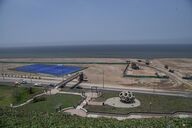
El Niño phenomenon on the north coast of Peru
Nicolas Réméné / Le Pictorium
LePictorium_0281305.jpg
Construction of the Alberto Junior Rodríguez Valdelomar sports ground in the San Miguel district of Lima, Peru, on 7 October 2018. Urban development work is trying to gain a little on the Peruvian capital's coastline. Lima, like many coastal towns and villages in the north has to deal regularly with the climatic hazards caused by the periodic alternation of the El Niño and La Niña phenomena. ---------------------------------------- The El Nino phenomenon on the north coast of Peru North of Lima in Peru, along almost 1300 km of coastline, many villages are periodically subjected to the climatic phenomena known as El Niño and La Niña. La Niña occurs more often, but is much less severe. As for El Niño, it recurs every 3 to 7 years. It is the result of disruptions to the oceanic and climatic system in the equatorial Pacific, particularly around the Peruvian and Ecuadorian coasts of South America. This phenomenon, which has a major influence on the world's climate, results in a surge of warm water in the Pacific Ocean and a rise in water levels that can lead to torrential rain, major flooding and landslides. These extreme weather events have had dramatic consequences for many of the villages along the coast. Many of these villages are fishing villages, where small-scale fishing is an essential part of the local economy, but El Niño has tended to warm surface waters, resulting in a reduction in plankton and therefore fish, turning the whole food chain upside down. In recent decades, the El Niño phenomenon has reappeared on several occasions, affecting ecosystems that are already particularly vulnerable to climate change, and causing a migratory flow of fish.
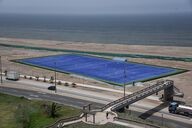
El Niño phenomenon on the north coast of Peru
Nicolas Réméné / Le Pictorium
LePictorium_0281306.jpg
Construction of the Alberto Junior Rodríguez Valdelomar sports ground in the San Miguel district of Lima, Peru, on 7 October 2018. Urban development work is trying to gain a little on the Peruvian capital's coastline. Lima, like many coastal towns and villages in the north has to deal regularly with the climatic hazards caused by the periodic alternation of the El Niño and La Niña phenomena. ---------------------------------------- The El Nino phenomenon on the north coast of Peru North of Lima in Peru, along almost 1300 km of coastline, many villages are periodically subjected to the climatic phenomena known as El Niño and La Niña. La Niña occurs more often, but is much less severe. As for El Niño, it recurs every 3 to 7 years. It is the result of disruptions to the oceanic and climatic system in the equatorial Pacific, particularly around the Peruvian and Ecuadorian coasts of South America. This phenomenon, which has a major influence on the world's climate, results in a surge of warm water in the Pacific Ocean and a rise in water levels that can lead to torrential rain, major flooding and landslides. These extreme weather events have had dramatic consequences for many of the villages along the coast. Many of these villages are fishing villages, where small-scale fishing is an essential part of the local economy, but El Niño has tended to warm surface waters, resulting in a reduction in plankton and therefore fish, turning the whole food chain upside down. In recent decades, the El Niño phenomenon has reappeared on several occasions, affecting ecosystems that are already particularly vulnerable to climate change, and causing a migratory flow of fish.
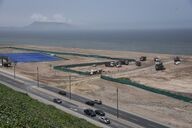
El Niño phenomenon on the north coast of Peru
Nicolas Réméné / Le Pictorium
LePictorium_0281307.jpg
Construction of the Alberto Junior Rodríguez Valdelomar sports ground in the San Miguel district of Lima, Peru, on 7 October 2018. Urban development work is trying to gain a little on the Peruvian capital's coastline. Lima, like many coastal towns and villages in the north has to deal regularly with the climatic hazards caused by the periodic alternation of the El Niño and La Niña phenomena. ---------------------------------------- The El Nino phenomenon on the north coast of Peru North of Lima in Peru, along almost 1300 km of coastline, many villages are periodically subjected to the climatic phenomena known as El Niño and La Niña. La Niña occurs more often, but is much less severe. As for El Niño, it recurs every 3 to 7 years. It is the result of disruptions to the oceanic and climatic system in the equatorial Pacific, particularly around the Peruvian and Ecuadorian coasts of South America. This phenomenon, which has a major influence on the world's climate, results in a surge of warm water in the Pacific Ocean and a rise in water levels that can lead to torrential rain, major flooding and landslides. These extreme weather events have had dramatic consequences for many of the villages along the coast. Many of these villages are fishing villages, where small-scale fishing is an essential part of the local economy, but El Niño has tended to warm surface waters, resulting in a reduction in plankton and therefore fish, turning the whole food chain upside down. In recent decades, the El Niño phenomenon has reappeared on several occasions, affecting ecosystems that are already particularly vulnerable to climate change, and causing a migratory flow of fish.
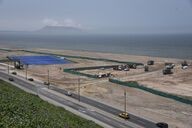
El Niño phenomenon on the north coast of Peru
Nicolas Réméné / Le Pictorium
LePictorium_0281308.jpg
Construction of the Alberto Junior Rodríguez Valdelomar sports ground in the San Miguel district of Lima, Peru, on 7 October 2018. Urban development work is trying to gain a little on the Peruvian capital's coastline. Lima, like many coastal towns and villages in the north has to deal regularly with the climatic hazards caused by the periodic alternation of the El Niño and La Niña phenomena. ---------------------------------------- The El Nino phenomenon on the north coast of Peru North of Lima in Peru, along almost 1300 km of coastline, many villages are periodically subjected to the climatic phenomena known as El Niño and La Niña. La Niña occurs more often, but is much less severe. As for El Niño, it recurs every 3 to 7 years. It is the result of disruptions to the oceanic and climatic system in the equatorial Pacific, particularly around the Peruvian and Ecuadorian coasts of South America. This phenomenon, which has a major influence on the world's climate, results in a surge of warm water in the Pacific Ocean and a rise in water levels that can lead to torrential rain, major flooding and landslides. These extreme weather events have had dramatic consequences for many of the villages along the coast. Many of these villages are fishing villages, where small-scale fishing is an essential part of the local economy, but El Niño has tended to warm surface waters, resulting in a reduction in plankton and therefore fish, turning the whole food chain upside down. In recent decades, the El Niño phenomenon has reappeared on several occasions, affecting ecosystems that are already particularly vulnerable to climate change, and causing a migratory flow of fish.
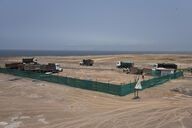
El Niño phenomenon on the north coast of Peru
Nicolas Réméné / Le Pictorium
LePictorium_0281309.jpg
Construction of the Alberto Junior Rodríguez Valdelomar sports ground in the San Miguel district of Lima, Peru, on 7 October 2018. Urban development work is trying to gain a little on the Peruvian capital's coastline. Lima, like many coastal towns and villages in the north has to deal regularly with the climatic hazards caused by the periodic alternation of the El Niño and La Niña phenomena. ---------------------------------------- The El Nino phenomenon on the north coast of Peru North of Lima in Peru, along almost 1300 km of coastline, many villages are periodically subjected to the climatic phenomena known as El Niño and La Niña. La Niña occurs more often, but is much less severe. As for El Niño, it recurs every 3 to 7 years. It is the result of disruptions to the oceanic and climatic system in the equatorial Pacific, particularly around the Peruvian and Ecuadorian coasts of South America. This phenomenon, which has a major influence on the world's climate, results in a surge of warm water in the Pacific Ocean and a rise in water levels that can lead to torrential rain, major flooding and landslides. These extreme weather events have had dramatic consequences for many of the villages along the coast. Many of these villages are fishing villages, where small-scale fishing is an essential part of the local economy, but El Niño has tended to warm surface waters, resulting in a reduction in plankton and therefore fish, turning the whole food chain upside down. In recent decades, the El Niño phenomenon has reappeared on several occasions, affecting ecosystems that are already particularly vulnerable to climate change, and causing a migratory flow of fish.
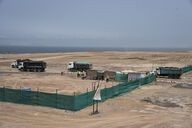
El Niño phenomenon on the north coast of Peru
Nicolas Réméné / Le Pictorium
LePictorium_0281310.jpg
Construction of the Alberto Junior Rodríguez Valdelomar sports ground in the San Miguel district of Lima, Peru, on 7 October 2018. Urban development work is trying to gain a little on the Peruvian capital's coastline. Lima, like many coastal towns and villages in the north has to deal regularly with the climatic hazards caused by the periodic alternation of the El Niño and La Niña phenomena. ---------------------------------------- The El Nino phenomenon on the north coast of Peru North of Lima in Peru, along almost 1300 km of coastline, many villages are periodically subjected to the climatic phenomena known as El Niño and La Niña. La Niña occurs more often, but is much less severe. As for El Niño, it recurs every 3 to 7 years. It is the result of disruptions to the oceanic and climatic system in the equatorial Pacific, particularly around the Peruvian and Ecuadorian coasts of South America. This phenomenon, which has a major influence on the world's climate, results in a surge of warm water in the Pacific Ocean and a rise in water levels that can lead to torrential rain, major flooding and landslides. These extreme weather events have had dramatic consequences for many of the villages along the coast. Many of these villages are fishing villages, where small-scale fishing is an essential part of the local economy, but El Niño has tended to warm surface waters, resulting in a reduction in plankton and therefore fish, turning the whole food chain upside down. In recent decades, the El Niño phenomenon has reappeared on several occasions, affecting ecosystems that are already particularly vulnerable to climate change, and causing a migratory flow of fish.
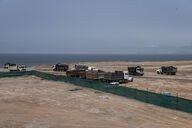
El Niño phenomenon on the north coast of Peru
Nicolas Réméné / Le Pictorium
LePictorium_0281311.jpg
Construction of the Alberto Junior Rodríguez Valdelomar sports ground in the San Miguel district of Lima, Peru, on 7 October 2018. Urban development work is trying to gain a little on the Peruvian capital's coastline. Lima, like many coastal towns and villages in the north has to deal regularly with the climatic hazards caused by the periodic alternation of the El Niño and La Niña phenomena. ---------------------------------------- The El Nino phenomenon on the north coast of Peru North of Lima in Peru, along almost 1300 km of coastline, many villages are periodically subjected to the climatic phenomena known as El Niño and La Niña. La Niña occurs more often, but is much less severe. As for El Niño, it recurs every 3 to 7 years. It is the result of disruptions to the oceanic and climatic system in the equatorial Pacific, particularly around the Peruvian and Ecuadorian coasts of South America. This phenomenon, which has a major influence on the world's climate, results in a surge of warm water in the Pacific Ocean and a rise in water levels that can lead to torrential rain, major flooding and landslides. These extreme weather events have had dramatic consequences for many of the villages along the coast. Many of these villages are fishing villages, where small-scale fishing is an essential part of the local economy, but El Niño has tended to warm surface waters, resulting in a reduction in plankton and therefore fish, turning the whole food chain upside down. In recent decades, the El Niño phenomenon has reappeared on several occasions, affecting ecosystems that are already particularly vulnerable to climate change, and causing a migratory flow of fish.
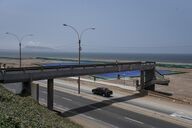
El Niño phenomenon on the north coast of Peru
Nicolas Réméné / Le Pictorium
LePictorium_0281312.jpg
Construction of the Alberto Junior Rodríguez Valdelomar sports ground in the San Miguel district of Lima, Peru, on 7 October 2018. Urban development work is trying to gain a little on the Peruvian capital's coastline. Lima, like many coastal towns and villages in the north has to deal regularly with the climatic hazards caused by the periodic alternation of the El Niño and La Niña phenomena. ---------------------------------------- The El Nino phenomenon on the north coast of Peru North of Lima in Peru, along almost 1300 km of coastline, many villages are periodically subjected to the climatic phenomena known as El Niño and La Niña. La Niña occurs more often, but is much less severe. As for El Niño, it recurs every 3 to 7 years. It is the result of disruptions to the oceanic and climatic system in the equatorial Pacific, particularly around the Peruvian and Ecuadorian coasts of South America. This phenomenon, which has a major influence on the world's climate, results in a surge of warm water in the Pacific Ocean and a rise in water levels that can lead to torrential rain, major flooding and landslides. These extreme weather events have had dramatic consequences for many of the villages along the coast. Many of these villages are fishing villages, where small-scale fishing is an essential part of the local economy, but El Niño has tended to warm surface waters, resulting in a reduction in plankton and therefore fish, turning the whole food chain upside down. In recent decades, the El Niño phenomenon has reappeared on several occasions, affecting ecosystems that are already particularly vulnerable to climate change, and causing a migratory flow of fish.
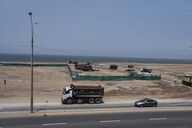
El Niño phenomenon on the north coast of Peru
Nicolas Réméné / Le Pictorium
LePictorium_0281313.jpg
Construction of the Alberto Junior Rodríguez Valdelomar sports ground in the San Miguel district of Lima, Peru, on 7 October 2018. Urban development work is trying to gain a little on the Peruvian capital's coastline. Lima, like many coastal towns and villages in the north has to deal regularly with the climatic hazards caused by the periodic alternation of the El Niño and La Niña phenomena. ---------------------------------------- The El Nino phenomenon on the north coast of Peru North of Lima in Peru, along almost 1300 km of coastline, many villages are periodically subjected to the climatic phenomena known as El Niño and La Niña. La Niña occurs more often, but is much less severe. As for El Niño, it recurs every 3 to 7 years. It is the result of disruptions to the oceanic and climatic system in the equatorial Pacific, particularly around the Peruvian and Ecuadorian coasts of South America. This phenomenon, which has a major influence on the world's climate, results in a surge of warm water in the Pacific Ocean and a rise in water levels that can lead to torrential rain, major flooding and landslides. These extreme weather events have had dramatic consequences for many of the villages along the coast. Many of these villages are fishing villages, where small-scale fishing is an essential part of the local economy, but El Niño has tended to warm surface waters, resulting in a reduction in plankton and therefore fish, turning the whole food chain upside down. In recent decades, the El Niño phenomenon has reappeared on several occasions, affecting ecosystems that are already particularly vulnerable to climate change, and causing a migratory flow of fish.
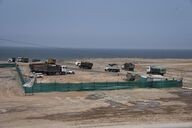
El Niño phenomenon on the north coast of Peru
Nicolas Réméné / Le Pictorium
LePictorium_0281314.jpg
Construction of the Alberto Junior Rodríguez Valdelomar sports ground in the San Miguel district of Lima, Peru, on 7 October 2018. Urban development work is trying to gain a little on the Peruvian capital's coastline. Lima, like many coastal towns and villages in the north has to deal regularly with the climatic hazards caused by the periodic alternation of the El Niño and La Niña phenomena. ---------------------------------------- The El Nino phenomenon on the north coast of Peru North of Lima in Peru, along almost 1300 km of coastline, many villages are periodically subjected to the climatic phenomena known as El Niño and La Niña. La Niña occurs more often, but is much less severe. As for El Niño, it recurs every 3 to 7 years. It is the result of disruptions to the oceanic and climatic system in the equatorial Pacific, particularly around the Peruvian and Ecuadorian coasts of South America. This phenomenon, which has a major influence on the world's climate, results in a surge of warm water in the Pacific Ocean and a rise in water levels that can lead to torrential rain, major flooding and landslides. These extreme weather events have had dramatic consequences for many of the villages along the coast. Many of these villages are fishing villages, where small-scale fishing is an essential part of the local economy, but El Niño has tended to warm surface waters, resulting in a reduction in plankton and therefore fish, turning the whole food chain upside down. In recent decades, the El Niño phenomenon has reappeared on several occasions, affecting ecosystems that are already particularly vulnerable to climate change, and causing a migratory flow of fish.
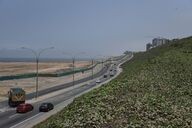
El Niño phenomenon on the north coast of Peru
Nicolas Réméné / Le Pictorium
LePictorium_0281315.jpg
Construction of the Alberto Junior Rodríguez Valdelomar sports ground in the San Miguel district of Lima, Peru, on 7 October 2018. Urban development work is trying to gain a little on the Peruvian capital's coastline. Lima, like many coastal towns and villages in the north has to deal regularly with the climatic hazards caused by the periodic alternation of the El Niño and La Niña phenomena. ---------------------------------------- The El Nino phenomenon on the north coast of Peru North of Lima in Peru, along almost 1300 km of coastline, many villages are periodically subjected to the climatic phenomena known as El Niño and La Niña. La Niña occurs more often, but is much less severe. As for El Niño, it recurs every 3 to 7 years. It is the result of disruptions to the oceanic and climatic system in the equatorial Pacific, particularly around the Peruvian and Ecuadorian coasts of South America. This phenomenon, which has a major influence on the world's climate, results in a surge of warm water in the Pacific Ocean and a rise in water levels that can lead to torrential rain, major flooding and landslides. These extreme weather events have had dramatic consequences for many of the villages along the coast. Many of these villages are fishing villages, where small-scale fishing is an essential part of the local economy, but El Niño has tended to warm surface waters, resulting in a reduction in plankton and therefore fish, turning the whole food chain upside down. In recent decades, the El Niño phenomenon has reappeared on several occasions, affecting ecosystems that are already particularly vulnerable to climate change, and causing a migratory flow of fish.
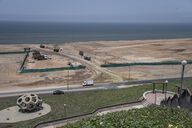
El Niño phenomenon on the north coast of Peru
Nicolas Réméné / Le Pictorium
LePictorium_0281316.jpg
Construction of the Alberto Junior Rodríguez Valdelomar sports ground in the San Miguel district of Lima, Peru, on 7 October 2018. Urban development work is trying to gain a little on the Peruvian capital's coastline. Lima, like many coastal towns and villages in the north has to deal regularly with the climatic hazards caused by the periodic alternation of the El Niño and La Niña phenomena. ---------------------------------------- The El Nino phenomenon on the north coast of Peru North of Lima in Peru, along almost 1300 km of coastline, many villages are periodically subjected to the climatic phenomena known as El Niño and La Niña. La Niña occurs more often, but is much less severe. As for El Niño, it recurs every 3 to 7 years. It is the result of disruptions to the oceanic and climatic system in the equatorial Pacific, particularly around the Peruvian and Ecuadorian coasts of South America. This phenomenon, which has a major influence on the world's climate, results in a surge of warm water in the Pacific Ocean and a rise in water levels that can lead to torrential rain, major flooding and landslides. These extreme weather events have had dramatic consequences for many of the villages along the coast. Many of these villages are fishing villages, where small-scale fishing is an essential part of the local economy, but El Niño has tended to warm surface waters, resulting in a reduction in plankton and therefore fish, turning the whole food chain upside down. In recent decades, the El Niño phenomenon has reappeared on several occasions, affecting ecosystems that are already particularly vulnerable to climate change, and causing a migratory flow of fish.
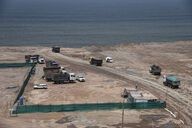
El Niño phenomenon on the north coast of Peru
Nicolas Réméné / Le Pictorium
LePictorium_0281317.jpg
Construction of the Alberto Junior Rodríguez Valdelomar sports ground in the San Miguel district of Lima, Peru, on 7 October 2018. Urban development work is trying to gain a little on the Peruvian capital's coastline. Lima, like many coastal towns and villages in the north has to deal regularly with the climatic hazards caused by the periodic alternation of the El Niño and La Niña phenomena. ---------------------------------------- The El Nino phenomenon on the north coast of Peru North of Lima in Peru, along almost 1300 km of coastline, many villages are periodically subjected to the climatic phenomena known as El Niño and La Niña. La Niña occurs more often, but is much less severe. As for El Niño, it recurs every 3 to 7 years. It is the result of disruptions to the oceanic and climatic system in the equatorial Pacific, particularly around the Peruvian and Ecuadorian coasts of South America. This phenomenon, which has a major influence on the world's climate, results in a surge of warm water in the Pacific Ocean and a rise in water levels that can lead to torrential rain, major flooding and landslides. These extreme weather events have had dramatic consequences for many of the villages along the coast. Many of these villages are fishing villages, where small-scale fishing is an essential part of the local economy, but El Niño has tended to warm surface waters, resulting in a reduction in plankton and therefore fish, turning the whole food chain upside down. In recent decades, the El Niño phenomenon has reappeared on several occasions, affecting ecosystems that are already particularly vulnerable to climate change, and causing a migratory flow of fish.
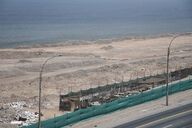
El Niño phenomenon on the north coast of Peru
Nicolas Réméné / Le Pictorium
LePictorium_0281318.jpg
Construction of the Alberto Junior Rodríguez Valdelomar sports ground in the San Miguel district of Lima, Peru, on 7 October 2018. Urban development work is trying to gain a little on the Peruvian capital's coastline. Lima, like many coastal towns and villages in the north has to deal regularly with the climatic hazards caused by the periodic alternation of the El Niño and La Niña phenomena. ---------------------------------------- The El Nino phenomenon on the north coast of Peru North of Lima in Peru, along almost 1300 km of coastline, many villages are periodically subjected to the climatic phenomena known as El Niño and La Niña. La Niña occurs more often, but is much less severe. As for El Niño, it recurs every 3 to 7 years. It is the result of disruptions to the oceanic and climatic system in the equatorial Pacific, particularly around the Peruvian and Ecuadorian coasts of South America. This phenomenon, which has a major influence on the world's climate, results in a surge of warm water in the Pacific Ocean and a rise in water levels that can lead to torrential rain, major flooding and landslides. These extreme weather events have had dramatic consequences for many of the villages along the coast. Many of these villages are fishing villages, where small-scale fishing is an essential part of the local economy, but El Niño has tended to warm surface waters, resulting in a reduction in plankton and therefore fish, turning the whole food chain upside down. In recent decades, the El Niño phenomenon has reappeared on several occasions, affecting ecosystems that are already particularly vulnerable to climate change, and causing a migratory flow of fish.
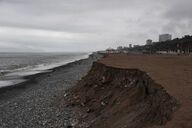
El Niño phenomenon on the north coast of Peru
Nicolas Réméné / Le Pictorium
LePictorium_0281264.jpg
Magdalena del Mar, a seaside district in the province of Lima in Peru, on 7 October 2018. Urban development work is trying to gain a little on the Peruvian capital's coastline. Lima, like many coastal towns and villages in the north has to deal regularly with the climatic hazards caused by the periodic alternation of the El Niño and La Niña phenomena. ---------------------------------------- The El Nino phenomenon on the north coast of Peru North of Lima in Peru, along almost 1300 km of coastline, many villages are periodically subjected to the climatic phenomena known as El Niño and La Niña. La Niña occurs more often, but is much less severe. As for El Niño, it recurs every 3 to 7 years. It is the result of disruptions to the oceanic and climatic system in the equatorial Pacific, particularly around the Peruvian and Ecuadorian coasts of South America. This phenomenon, which has a major influence on the world's climate, results in a surge of warm water in the Pacific Ocean and a rise in water levels that can lead to torrential rain, major flooding and landslides. These extreme weather events have had dramatic consequences for many of the villages along the coast. Many of these villages are fishing villages, where small-scale fishing is an essential part of the local economy, but El Niño has tended to warm surface waters, resulting in a reduction in plankton and therefore fish, turning the whole food chain upside down. In recent decades, the El Niño phenomenon has reappeared on several occasions, affecting ecosystems that are already particularly vulnerable to climate change, and causing a migratory flow of fish.
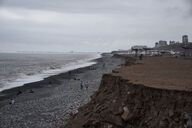
El Niño phenomenon on the north coast of Peru
Nicolas Réméné / Le Pictorium
LePictorium_0281265.jpg
Magdalena del Mar, a seaside district in the province of Lima in Peru, on 7 October 2018. Urban development work is trying to gain a little on the Peruvian capital's coastline. Lima, like many coastal towns and villages in the north has to deal regularly with the climatic hazards caused by the periodic alternation of the El Niño and La Niña phenomena. ---------------------------------------- The El Nino phenomenon on the north coast of Peru North of Lima in Peru, along almost 1300 km of coastline, many villages are periodically subjected to the climatic phenomena known as El Niño and La Niña. La Niña occurs more often, but is much less severe. As for El Niño, it recurs every 3 to 7 years. It is the result of disruptions to the oceanic and climatic system in the equatorial Pacific, particularly around the Peruvian and Ecuadorian coasts of South America. This phenomenon, which has a major influence on the world's climate, results in a surge of warm water in the Pacific Ocean and a rise in water levels that can lead to torrential rain, major flooding and landslides. These extreme weather events have had dramatic consequences for many of the villages along the coast. Many of these villages are fishing villages, where small-scale fishing is an essential part of the local economy, but El Niño has tended to warm surface waters, resulting in a reduction in plankton and therefore fish, turning the whole food chain upside down. In recent decades, the El Niño phenomenon has reappeared on several occasions, affecting ecosystems that are already particularly vulnerable to climate change, and causing a migratory flow of fish.
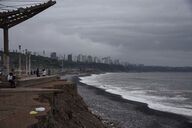
El Niño phenomenon on the north coast of Peru
Nicolas Réméné / Le Pictorium
LePictorium_0281266.jpg
Magdalena del Mar, a seaside district in the province of Lima in Peru, on 7 October 2018. Urban development work is trying to gain a little on the Peruvian capital's coastline. Lima, like many coastal towns and villages in the north has to deal regularly with the climatic hazards caused by the periodic alternation of the El Niño and La Niña phenomena. ---------------------------------------- The El Nino phenomenon on the north coast of Peru North of Lima in Peru, along almost 1300 km of coastline, many villages are periodically subjected to the climatic phenomena known as El Niño and La Niña. La Niña occurs more often, but is much less severe. As for El Niño, it recurs every 3 to 7 years. It is the result of disruptions to the oceanic and climatic system in the equatorial Pacific, particularly around the Peruvian and Ecuadorian coasts of South America. This phenomenon, which has a major influence on the world's climate, results in a surge of warm water in the Pacific Ocean and a rise in water levels that can lead to torrential rain, major flooding and landslides. These extreme weather events have had dramatic consequences for many of the villages along the coast. Many of these villages are fishing villages, where small-scale fishing is an essential part of the local economy, but El Niño has tended to warm surface waters, resulting in a reduction in plankton and therefore fish, turning the whole food chain upside down. In recent decades, the El Niño phenomenon has reappeared on several occasions, affecting ecosystems that are already particularly vulnerable to climate change, and causing a migratory flow of fish.
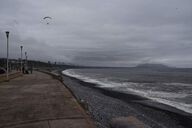
El Niño phenomenon on the north coast of Peru
Nicolas Réméné / Le Pictorium
LePictorium_0281267.jpg
Magdalena del Mar, a seaside district in the province of Lima in Peru, on 7 October 2018. Urban development work is trying to gain a little on the Peruvian capital's coastline. Lima, like many coastal towns and villages in the north has to deal regularly with the climatic hazards caused by the periodic alternation of the El Niño and La Niña phenomena. ---------------------------------------- The El Nino phenomenon on the north coast of Peru North of Lima in Peru, along almost 1300 km of coastline, many villages are periodically subjected to the climatic phenomena known as El Niño and La Niña. La Niña occurs more often, but is much less severe. As for El Niño, it recurs every 3 to 7 years. It is the result of disruptions to the oceanic and climatic system in the equatorial Pacific, particularly around the Peruvian and Ecuadorian coasts of South America. This phenomenon, which has a major influence on the world's climate, results in a surge of warm water in the Pacific Ocean and a rise in water levels that can lead to torrential rain, major flooding and landslides. These extreme weather events have had dramatic consequences for many of the villages along the coast. Many of these villages are fishing villages, where small-scale fishing is an essential part of the local economy, but El Niño has tended to warm surface waters, resulting in a reduction in plankton and therefore fish, turning the whole food chain upside down. In recent decades, the El Niño phenomenon has reappeared on several occasions, affecting ecosystems that are already particularly vulnerable to climate change, and causing a migratory flow of fish.
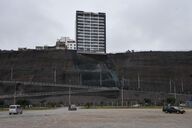
El Niño phenomenon on the north coast of Peru
Nicolas Réméné / Le Pictorium
LePictorium_0281268.jpg
Magdalena del Mar, a seaside district in the province of Lima in Peru, on 7 October 2018. Urban development work is trying to gain a little on the Peruvian capital's coastline. Lima, like many coastal towns and villages in the north has to deal regularly with the climatic hazards caused by the periodic alternation of the El Niño and La Niña phenomena. ---------------------------------------- The El Nino phenomenon on the north coast of Peru North of Lima in Peru, along almost 1300 km of coastline, many villages are periodically subjected to the climatic phenomena known as El Niño and La Niña. La Niña occurs more often, but is much less severe. As for El Niño, it recurs every 3 to 7 years. It is the result of disruptions to the oceanic and climatic system in the equatorial Pacific, particularly around the Peruvian and Ecuadorian coasts of South America. This phenomenon, which has a major influence on the world's climate, results in a surge of warm water in the Pacific Ocean and a rise in water levels that can lead to torrential rain, major flooding and landslides. These extreme weather events have had dramatic consequences for many of the villages along the coast. Many of these villages are fishing villages, where small-scale fishing is an essential part of the local economy, but El Niño has tended to warm surface waters, resulting in a reduction in plankton and therefore fish, turning the whole food chain upside down. In recent decades, the El Niño phenomenon has reappeared on several occasions, affecting ecosystems that are already particularly vulnerable to climate change, and causing a migratory flow of fish.
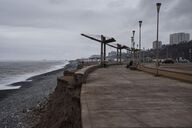
El Niño phenomenon on the north coast of Peru
Nicolas Réméné / Le Pictorium
LePictorium_0281269.jpg
Magdalena del Mar, a seaside district in the province of Lima in Peru, on 7 October 2018. Urban development work is trying to gain a little on the Peruvian capital's coastline. Lima, like many coastal towns and villages in the north has to deal regularly with the climatic hazards caused by the periodic alternation of the El Niño and La Niña phenomena. ---------------------------------------- The El Nino phenomenon on the north coast of Peru North of Lima in Peru, along almost 1300 km of coastline, many villages are periodically subjected to the climatic phenomena known as El Niño and La Niña. La Niña occurs more often, but is much less severe. As for El Niño, it recurs every 3 to 7 years. It is the result of disruptions to the oceanic and climatic system in the equatorial Pacific, particularly around the Peruvian and Ecuadorian coasts of South America. This phenomenon, which has a major influence on the world's climate, results in a surge of warm water in the Pacific Ocean and a rise in water levels that can lead to torrential rain, major flooding and landslides. These extreme weather events have had dramatic consequences for many of the villages along the coast. Many of these villages are fishing villages, where small-scale fishing is an essential part of the local economy, but El Niño has tended to warm surface waters, resulting in a reduction in plankton and therefore fish, turning the whole food chain upside down. In recent decades, the El Niño phenomenon has reappeared on several occasions, affecting ecosystems that are already particularly vulnerable to climate change, and causing a migratory flow of fish.
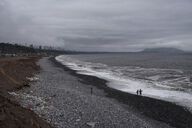
El Niño phenomenon on the north coast of Peru
Nicolas Réméné / Le Pictorium
LePictorium_0281270.jpg
Magdalena del Mar, a seaside district in the province of Lima in Peru, on 7 October 2018. Urban development work is trying to gain a little on the Peruvian capital's coastline. Lima, like many coastal towns and villages in the north has to deal regularly with the climatic hazards caused by the periodic alternation of the El Niño and La Niña phenomena. ---------------------------------------- The El Nino phenomenon on the north coast of Peru North of Lima in Peru, along almost 1300 km of coastline, many villages are periodically subjected to the climatic phenomena known as El Niño and La Niña. La Niña occurs more often, but is much less severe. As for El Niño, it recurs every 3 to 7 years. It is the result of disruptions to the oceanic and climatic system in the equatorial Pacific, particularly around the Peruvian and Ecuadorian coasts of South America. This phenomenon, which has a major influence on the world's climate, results in a surge of warm water in the Pacific Ocean and a rise in water levels that can lead to torrential rain, major flooding and landslides. These extreme weather events have had dramatic consequences for many of the villages along the coast. Many of these villages are fishing villages, where small-scale fishing is an essential part of the local economy, but El Niño has tended to warm surface waters, resulting in a reduction in plankton and therefore fish, turning the whole food chain upside down. In recent decades, the El Niño phenomenon has reappeared on several occasions, affecting ecosystems that are already particularly vulnerable to climate change, and causing a migratory flow of fish.
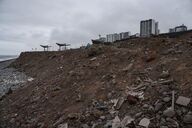
El Niño phenomenon on the north coast of Peru
Nicolas Réméné / Le Pictorium
LePictorium_0281271.jpg
Magdalena del Mar, a seaside district in the province of Lima in Peru, on 7 October 2018. Urban development work is trying to gain a little on the Peruvian capital's coastline. Lima, like many coastal towns and villages in the north has to deal regularly with the climatic hazards caused by the periodic alternation of the El Niño and La Niña phenomena. ---------------------------------------- The El Nino phenomenon on the north coast of Peru North of Lima in Peru, along almost 1300 km of coastline, many villages are periodically subjected to the climatic phenomena known as El Niño and La Niña. La Niña occurs more often, but is much less severe. As for El Niño, it recurs every 3 to 7 years. It is the result of disruptions to the oceanic and climatic system in the equatorial Pacific, particularly around the Peruvian and Ecuadorian coasts of South America. This phenomenon, which has a major influence on the world's climate, results in a surge of warm water in the Pacific Ocean and a rise in water levels that can lead to torrential rain, major flooding and landslides. These extreme weather events have had dramatic consequences for many of the villages along the coast. Many of these villages are fishing villages, where small-scale fishing is an essential part of the local economy, but El Niño has tended to warm surface waters, resulting in a reduction in plankton and therefore fish, turning the whole food chain upside down. In recent decades, the El Niño phenomenon has reappeared on several occasions, affecting ecosystems that are already particularly vulnerable to climate change, and causing a migratory flow of fish.
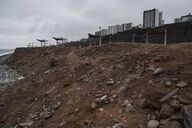
El Niño phenomenon on the north coast of Peru
Nicolas Réméné / Le Pictorium
LePictorium_0281272.jpg
Magdalena del Mar, a seaside district in the province of Lima in Peru, on 7 October 2018. Urban development work is trying to gain a little on the Peruvian capital's coastline. Lima, like many coastal towns and villages in the north has to deal regularly with the climatic hazards caused by the periodic alternation of the El Niño and La Niña phenomena. ---------------------------------------- The El Nino phenomenon on the north coast of Peru North of Lima in Peru, along almost 1300 km of coastline, many villages are periodically subjected to the climatic phenomena known as El Niño and La Niña. La Niña occurs more often, but is much less severe. As for El Niño, it recurs every 3 to 7 years. It is the result of disruptions to the oceanic and climatic system in the equatorial Pacific, particularly around the Peruvian and Ecuadorian coasts of South America. This phenomenon, which has a major influence on the world's climate, results in a surge of warm water in the Pacific Ocean and a rise in water levels that can lead to torrential rain, major flooding and landslides. These extreme weather events have had dramatic consequences for many of the villages along the coast. Many of these villages are fishing villages, where small-scale fishing is an essential part of the local economy, but El Niño has tended to warm surface waters, resulting in a reduction in plankton and therefore fish, turning the whole food chain upside down. In recent decades, the El Niño phenomenon has reappeared on several occasions, affecting ecosystems that are already particularly vulnerable to climate change, and causing a migratory flow of fish.
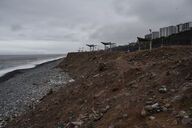
El Niño phenomenon on the north coast of Peru
Nicolas Réméné / Le Pictorium
LePictorium_0281273.jpg
Magdalena del Mar, a seaside district in the province of Lima in Peru, on 7 October 2018. Urban development work is trying to gain a little on the Peruvian capital's coastline. Lima, like many coastal towns and villages in the north has to deal regularly with the climatic hazards caused by the periodic alternation of the El Niño and La Niña phenomena. ---------------------------------------- The El Nino phenomenon on the north coast of Peru North of Lima in Peru, along almost 1300 km of coastline, many villages are periodically subjected to the climatic phenomena known as El Niño and La Niña. La Niña occurs more often, but is much less severe. As for El Niño, it recurs every 3 to 7 years. It is the result of disruptions to the oceanic and climatic system in the equatorial Pacific, particularly around the Peruvian and Ecuadorian coasts of South America. This phenomenon, which has a major influence on the world's climate, results in a surge of warm water in the Pacific Ocean and a rise in water levels that can lead to torrential rain, major flooding and landslides. These extreme weather events have had dramatic consequences for many of the villages along the coast. Many of these villages are fishing villages, where small-scale fishing is an essential part of the local economy, but El Niño has tended to warm surface waters, resulting in a reduction in plankton and therefore fish, turning the whole food chain upside down. In recent decades, the El Niño phenomenon has reappeared on several occasions, affecting ecosystems that are already particularly vulnerable to climate change, and causing a migratory flow of fish.
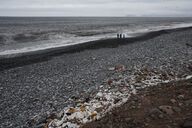
El Niño phenomenon on the north coast of Peru
Nicolas Réméné / Le Pictorium
LePictorium_0281274.jpg
Magdalena del Mar, a seaside district in the province of Lima in Peru, on 7 October 2018. Urban development work is trying to gain a little on the Peruvian capital's coastline. Lima, like many coastal towns and villages in the north has to deal regularly with the climatic hazards caused by the periodic alternation of the El Niño and La Niña phenomena. ---------------------------------------- The El Nino phenomenon on the north coast of Peru North of Lima in Peru, along almost 1300 km of coastline, many villages are periodically subjected to the climatic phenomena known as El Niño and La Niña. La Niña occurs more often, but is much less severe. As for El Niño, it recurs every 3 to 7 years. It is the result of disruptions to the oceanic and climatic system in the equatorial Pacific, particularly around the Peruvian and Ecuadorian coasts of South America. This phenomenon, which has a major influence on the world's climate, results in a surge of warm water in the Pacific Ocean and a rise in water levels that can lead to torrential rain, major flooding and landslides. These extreme weather events have had dramatic consequences for many of the villages along the coast. Many of these villages are fishing villages, where small-scale fishing is an essential part of the local economy, but El Niño has tended to warm surface waters, resulting in a reduction in plankton and therefore fish, turning the whole food chain upside down. In recent decades, the El Niño phenomenon has reappeared on several occasions, affecting ecosystems that are already particularly vulnerable to climate change, and causing a migratory flow of fish.
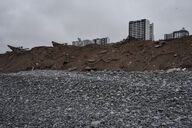
El Niño phenomenon on the north coast of Peru
Nicolas Réméné / Le Pictorium
LePictorium_0281275.jpg
Magdalena del Mar, a seaside district in the province of Lima in Peru, on 7 October 2018. Urban development work is trying to gain a little on the Peruvian capital's coastline. Lima, like many coastal towns and villages in the north has to deal regularly with the climatic hazards caused by the periodic alternation of the El Niño and La Niña phenomena. ---------------------------------------- The El Nino phenomenon on the north coast of Peru North of Lima in Peru, along almost 1300 km of coastline, many villages are periodically subjected to the climatic phenomena known as El Niño and La Niña. La Niña occurs more often, but is much less severe. As for El Niño, it recurs every 3 to 7 years. It is the result of disruptions to the oceanic and climatic system in the equatorial Pacific, particularly around the Peruvian and Ecuadorian coasts of South America. This phenomenon, which has a major influence on the world's climate, results in a surge of warm water in the Pacific Ocean and a rise in water levels that can lead to torrential rain, major flooding and landslides. These extreme weather events have had dramatic consequences for many of the villages along the coast. Many of these villages are fishing villages, where small-scale fishing is an essential part of the local economy, but El Niño has tended to warm surface waters, resulting in a reduction in plankton and therefore fish, turning the whole food chain upside down. In recent decades, the El Niño phenomenon has reappeared on several occasions, affecting ecosystems that are already particularly vulnerable to climate change, and causing a migratory flow of fish.
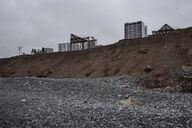
El Niño phenomenon on the north coast of Peru
Nicolas Réméné / Le Pictorium
LePictorium_0281276.jpg
Magdalena del Mar, a seaside district in the province of Lima in Peru, on 7 October 2018. Urban development work is trying to gain a little on the Peruvian capital's coastline. Lima, like many coastal towns and villages in the north has to deal regularly with the climatic hazards caused by the periodic alternation of the El Niño and La Niña phenomena. ---------------------------------------- The El Nino phenomenon on the north coast of Peru North of Lima in Peru, along almost 1300 km of coastline, many villages are periodically subjected to the climatic phenomena known as El Niño and La Niña. La Niña occurs more often, but is much less severe. As for El Niño, it recurs every 3 to 7 years. It is the result of disruptions to the oceanic and climatic system in the equatorial Pacific, particularly around the Peruvian and Ecuadorian coasts of South America. This phenomenon, which has a major influence on the world's climate, results in a surge of warm water in the Pacific Ocean and a rise in water levels that can lead to torrential rain, major flooding and landslides. These extreme weather events have had dramatic consequences for many of the villages along the coast. Many of these villages are fishing villages, where small-scale fishing is an essential part of the local economy, but El Niño has tended to warm surface waters, resulting in a reduction in plankton and therefore fish, turning the whole food chain upside down. In recent decades, the El Niño phenomenon has reappeared on several occasions, affecting ecosystems that are already particularly vulnerable to climate change, and causing a migratory flow of fish.
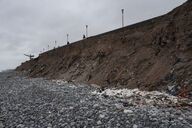
El Niño phenomenon on the north coast of Peru
Nicolas Réméné / Le Pictorium
LePictorium_0281277.jpg
Magdalena del Mar, a seaside district in the province of Lima in Peru, on 7 October 2018. Urban development work is trying to gain a little on the Peruvian capital's coastline. Lima, like many coastal towns and villages in the north has to deal regularly with the climatic hazards caused by the periodic alternation of the El Niño and La Niña phenomena. ---------------------------------------- The El Nino phenomenon on the north coast of Peru North of Lima in Peru, along almost 1300 km of coastline, many villages are periodically subjected to the climatic phenomena known as El Niño and La Niña. La Niña occurs more often, but is much less severe. As for El Niño, it recurs every 3 to 7 years. It is the result of disruptions to the oceanic and climatic system in the equatorial Pacific, particularly around the Peruvian and Ecuadorian coasts of South America. This phenomenon, which has a major influence on the world's climate, results in a surge of warm water in the Pacific Ocean and a rise in water levels that can lead to torrential rain, major flooding and landslides. These extreme weather events have had dramatic consequences for many of the villages along the coast. Many of these villages are fishing villages, where small-scale fishing is an essential part of the local economy, but El Niño has tended to warm surface waters, resulting in a reduction in plankton and therefore fish, turning the whole food chain upside down. In recent decades, the El Niño phenomenon has reappeared on several occasions, affecting ecosystems that are already particularly vulnerable to climate change, and causing a migratory flow of fish.
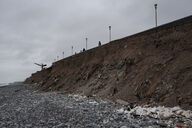
El Niño phenomenon on the north coast of Peru
Nicolas Réméné / Le Pictorium
LePictorium_0281278.jpg
Magdalena del Mar, a seaside district in the province of Lima in Peru, on 7 October 2018. Urban development work is trying to gain a little on the Peruvian capital's coastline. Lima, like many coastal towns and villages in the north has to deal regularly with the climatic hazards caused by the periodic alternation of the El Niño and La Niña phenomena. ---------------------------------------- The El Nino phenomenon on the north coast of Peru North of Lima in Peru, along almost 1300 km of coastline, many villages are periodically subjected to the climatic phenomena known as El Niño and La Niña. La Niña occurs more often, but is much less severe. As for El Niño, it recurs every 3 to 7 years. It is the result of disruptions to the oceanic and climatic system in the equatorial Pacific, particularly around the Peruvian and Ecuadorian coasts of South America. This phenomenon, which has a major influence on the world's climate, results in a surge of warm water in the Pacific Ocean and a rise in water levels that can lead to torrential rain, major flooding and landslides. These extreme weather events have had dramatic consequences for many of the villages along the coast. Many of these villages are fishing villages, where small-scale fishing is an essential part of the local economy, but El Niño has tended to warm surface waters, resulting in a reduction in plankton and therefore fish, turning the whole food chain upside down. In recent decades, the El Niño phenomenon has reappeared on several occasions, affecting ecosystems that are already particularly vulnerable to climate change, and causing a migratory flow of fish.
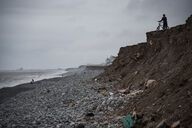
El Niño phenomenon on the north coast of Peru
Nicolas Réméné / Le Pictorium
LePictorium_0281279.jpg
Magdalena del Mar, a seaside district in the province of Lima in Peru, on 7 October 2018. Urban development work is trying to gain a little on the Peruvian capital's coastline. Lima, like many coastal towns and villages in the north has to deal regularly with the climatic hazards caused by the periodic alternation of the El Niño and La Niña phenomena. ---------------------------------------- The El Nino phenomenon on the north coast of Peru North of Lima in Peru, along almost 1300 km of coastline, many villages are periodically subjected to the climatic phenomena known as El Niño and La Niña. La Niña occurs more often, but is much less severe. As for El Niño, it recurs every 3 to 7 years. It is the result of disruptions to the oceanic and climatic system in the equatorial Pacific, particularly around the Peruvian and Ecuadorian coasts of South America. This phenomenon, which has a major influence on the world's climate, results in a surge of warm water in the Pacific Ocean and a rise in water levels that can lead to torrential rain, major flooding and landslides. These extreme weather events have had dramatic consequences for many of the villages along the coast. Many of these villages are fishing villages, where small-scale fishing is an essential part of the local economy, but El Niño has tended to warm surface waters, resulting in a reduction in plankton and therefore fish, turning the whole food chain upside down. In recent decades, the El Niño phenomenon has reappeared on several occasions, affecting ecosystems that are already particularly vulnerable to climate change, and causing a migratory flow of fish.
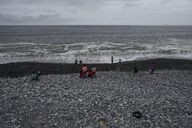
El Niño phenomenon on the north coast of Peru
Nicolas Réméné / Le Pictorium
LePictorium_0281280.jpg
Magdalena del Mar, a seaside district in the province of Lima in Peru, on 7 October 2018. Urban development work is trying to gain a little on the Peruvian capital's coastline. Lima, like many coastal towns and villages in the north has to deal regularly with the climatic hazards caused by the periodic alternation of the El Niño and La Niña phenomena. ---------------------------------------- The El Nino phenomenon on the north coast of Peru North of Lima in Peru, along almost 1300 km of coastline, many villages are periodically subjected to the climatic phenomena known as El Niño and La Niña. La Niña occurs more often, but is much less severe. As for El Niño, it recurs every 3 to 7 years. It is the result of disruptions to the oceanic and climatic system in the equatorial Pacific, particularly around the Peruvian and Ecuadorian coasts of South America. This phenomenon, which has a major influence on the world's climate, results in a surge of warm water in the Pacific Ocean and a rise in water levels that can lead to torrential rain, major flooding and landslides. These extreme weather events have had dramatic consequences for many of the villages along the coast. Many of these villages are fishing villages, where small-scale fishing is an essential part of the local economy, but El Niño has tended to warm surface waters, resulting in a reduction in plankton and therefore fish, turning the whole food chain upside down. In recent decades, the El Niño phenomenon has reappeared on several occasions, affecting ecosystems that are already particularly vulnerable to climate change, and causing a migratory flow of fish.
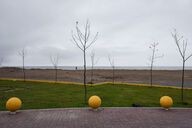
El Niño phenomenon on the north coast of Peru
Nicolas Réméné / Le Pictorium
LePictorium_0281281.jpg
Magdalena del Mar, a seaside district in the province of Lima in Peru, on 7 October 2018. Urban development work is trying to gain a little on the Peruvian capital's coastline. Lima, like many coastal towns and villages in the north has to deal regularly with the climatic hazards caused by the periodic alternation of the El Niño and La Niña phenomena. ---------------------------------------- The El Nino phenomenon on the north coast of Peru North of Lima in Peru, along almost 1300 km of coastline, many villages are periodically subjected to the climatic phenomena known as El Niño and La Niña. La Niña occurs more often, but is much less severe. As for El Niño, it recurs every 3 to 7 years. It is the result of disruptions to the oceanic and climatic system in the equatorial Pacific, particularly around the Peruvian and Ecuadorian coasts of South America. This phenomenon, which has a major influence on the world's climate, results in a surge of warm water in the Pacific Ocean and a rise in water levels that can lead to torrential rain, major flooding and landslides. These extreme weather events have had dramatic consequences for many of the villages along the coast. Many of these villages are fishing villages, where small-scale fishing is an essential part of the local economy, but El Niño has tended to warm surface waters, resulting in a reduction in plankton and therefore fish, turning the whole food chain upside down. In recent decades, the El Niño phenomenon has reappeared on several occasions, affecting ecosystems that are already particularly vulnerable to climate change, and causing a migratory flow of fish.
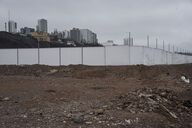
El Niño phenomenon on the north coast of Peru
Nicolas Réméné / Le Pictorium
LePictorium_0281282.jpg
Magdalena del Mar, a seaside district in the province of Lima in Peru, on 7 October 2018. Urban development work is trying to gain a little on the Peruvian capital's coastline. Lima, like many coastal towns and villages in the north has to deal regularly with the climatic hazards caused by the periodic alternation of the El Niño and La Niña phenomena. ---------------------------------------- The El Nino phenomenon on the north coast of Peru North of Lima in Peru, along almost 1300 km of coastline, many villages are periodically subjected to the climatic phenomena known as El Niño and La Niña. La Niña occurs more often, but is much less severe. As for El Niño, it recurs every 3 to 7 years. It is the result of disruptions to the oceanic and climatic system in the equatorial Pacific, particularly around the Peruvian and Ecuadorian coasts of South America. This phenomenon, which has a major influence on the world's climate, results in a surge of warm water in the Pacific Ocean and a rise in water levels that can lead to torrential rain, major flooding and landslides. These extreme weather events have had dramatic consequences for many of the villages along the coast. Many of these villages are fishing villages, where small-scale fishing is an essential part of the local economy, but El Niño has tended to warm surface waters, resulting in a reduction in plankton and therefore fish, turning the whole food chain upside down. In recent decades, the El Niño phenomenon has reappeared on several occasions, affecting ecosystems that are already particularly vulnerable to climate change, and causing a migratory flow of fish.
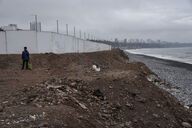
El Niño phenomenon on the north coast of Peru
Nicolas Réméné / Le Pictorium
LePictorium_0281283.jpg
Magdalena del Mar, a seaside district in the province of Lima in Peru, on 7 October 2018. Urban development work is trying to gain a little on the Peruvian capital's coastline. Lima, like many coastal towns and villages in the north has to deal regularly with the climatic hazards caused by the periodic alternation of the El Niño and La Niña phenomena. ---------------------------------------- The El Nino phenomenon on the north coast of Peru North of Lima in Peru, along almost 1300 km of coastline, many villages are periodically subjected to the climatic phenomena known as El Niño and La Niña. La Niña occurs more often, but is much less severe. As for El Niño, it recurs every 3 to 7 years. It is the result of disruptions to the oceanic and climatic system in the equatorial Pacific, particularly around the Peruvian and Ecuadorian coasts of South America. This phenomenon, which has a major influence on the world's climate, results in a surge of warm water in the Pacific Ocean and a rise in water levels that can lead to torrential rain, major flooding and landslides. These extreme weather events have had dramatic consequences for many of the villages along the coast. Many of these villages are fishing villages, where small-scale fishing is an essential part of the local economy, but El Niño has tended to warm surface waters, resulting in a reduction in plankton and therefore fish, turning the whole food chain upside down. In recent decades, the El Niño phenomenon has reappeared on several occasions, affecting ecosystems that are already particularly vulnerable to climate change, and causing a migratory flow of fish.
Next page
